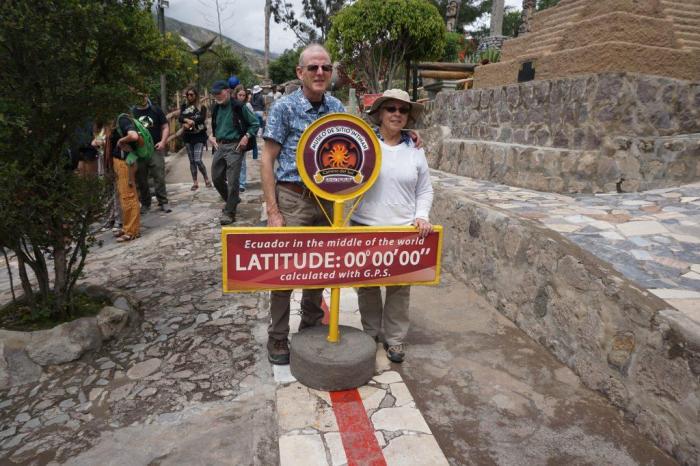Costa rica and the equator – Costa Rica, a vibrant nation nestled at the equator, beckons travelers with its captivating fusion of nature’s wonders. The country’s proximity to the Earth’s central line profoundly shapes its climate, ecosystem, and the tapestry of life within.
From the verdant rainforests teeming with biodiversity to the sun-kissed beaches, the equator’s influence is woven into the very fabric of Costa Rican life. This enchanting destination invites us to explore the intricate dance between geography and nature, revealing a world of extraordinary beauty and ecological significance.
Costa Rica’s Geographical Proximity to the Equator

Costa Rica, a Central American country, is situated just a few degrees north of the equator. This unique location has a profound impact on the country’s climate, biodiversity, and natural environment.
The proximity to the equator results in a tropical climate, characterized by consistently high temperatures and abundant rainfall. The country experiences two distinct seasons: a wet season from May to October and a dry season from November to April. The wet season brings heavy rainfall, particularly in the mountainous regions, while the dry season is relatively drier with less precipitation.
Implications for Climate
- Warm temperatures:Costa Rica’s proximity to the equator ensures year-round warm temperatures, with average temperatures ranging from 25 to 28 degrees Celsius (77 to 82 degrees Fahrenheit).
- High humidity:The country’s location also contributes to high humidity levels, especially during the wet season, which can make the air feel muggy and uncomfortable.
- Rainfall patterns:The wet and dry seasons are a direct result of Costa Rica’s proximity to the equator. The Intertropical Convergence Zone (ITCZ), a band of low atmospheric pressure near the equator, brings heavy rainfall during the wet season, while the ITCZ shifts away from the country during the dry season.
Implications for Biodiversity
- Diverse ecosystems:The varied climate and rainfall patterns create a diverse range of ecosystems in Costa Rica, including rainforests, cloud forests, dry forests, and coastal mangroves.
- Abundant wildlife:The country’s proximity to the equator supports a wide variety of flora and fauna, making it a biodiversity hotspot. Costa Rica is home to over 500,000 species, including monkeys, sloths, jaguars, and a vast array of bird species.
Impact of the Equator on Costa Rica’s Climate

Costa Rica’s proximity to the equator significantly influences its climate, shaping its weather patterns and contributing to its unique biodiversity. The country experiences a tropical climate characterized by high temperatures, abundant precipitation, and consistent humidity.
Temperature
The equator’s position near Costa Rica ensures warm temperatures throughout the year. The average temperature ranges from 25 to 28 degrees Celsius (77 to 82 degrees Fahrenheit), with little variation between seasons. This consistent warmth promotes lush vegetation and supports a wide variety of plant and animal life.
Precipitation
Costa Rica’s equatorial location also contributes to its high levels of precipitation. The country receives an average of 2,000 to 4,000 millimeters (79 to 157 inches) of rain annually. The rainy season typically lasts from May to November, while the dry season spans from December to April.
This abundant rainfall sustains Costa Rica’s rainforests and supports its thriving agricultural industry.
Humidity
The equator’s proximity to Costa Rica also influences its humidity levels. The country experiences high humidity throughout the year, with an average of 75% to 85%. This humidity contributes to the lush vegetation and can also lead to increased heat index values, making it feel even warmer than the actual temperature.
The Equator and Costa Rica’s Biodiversity

Biodiversity, the variety of life on Earth, is essential for the planet’s health and well-being. Costa Rica, nestled near the equator, boasts an astonishingly rich biodiversity due to its unique geographical location.
Costa Rica lies near the equator, where the sun’s rays are nearly perpendicular. This intense sunlight can cause various health issues, including head of fibula sticks out, a condition where the head of the fibula bone protrudes from the leg.
Click here for more information about this condition. Fortunately, Costa Rica’s lush rainforests provide ample shade, helping to mitigate the effects of the equatorial sun and reduce the risk of such health problems.
The equator’s proximity to Costa Rica creates a warm and humid climate that supports a diverse range of ecosystems, from rainforests to cloud forests to coastal wetlands. This diversity of habitats fosters a remarkable variety of plant and animal species.
Unique Flora
- Guaria Morada (Guaria morada): This stunning orchid, Costa Rica’s national flower, is found only in the country’s cloud forests.
- Bromeliads: These epiphytic plants, commonly known as air plants, thrive in Costa Rica’s humid rainforests, adding a splash of color to the canopy.
Unique Fauna
- Resplendent Quetzal (Pharomachrus mocinno): This iridescent bird, a symbol of Costa Rica, inhabits the country’s cloud forests.
- Green Macaw (Ara ambigua): These vibrant parrots are found in Costa Rica’s coastal forests and mangroves.
- Golden Toad (Incilius periglenes): Once abundant in Costa Rica’s rainforests, this species has sadly become extinct due to habitat loss and climate change.
The Equator’s Influence on Costa Rica’s Agriculture

The equator plays a significant role in shaping the agricultural practices and productivity of Costa Rica. The country’s location near the equator provides a unique combination of favorable climatic conditions and challenges for farmers.
Costa Rica’s agriculture is characterized by a diverse range of products, including coffee, bananas, pineapples, sugarcane, and livestock. The country is renowned for its high-quality coffee, which benefits from the equatorial climate’s consistent temperatures and ample rainfall.
Agricultural Practices and Products
The equatorial climate allows for year-round crop cultivation, with minimal seasonal variations. This enables farmers to produce multiple harvests throughout the year, increasing their productivity and income potential.
Costa Rican farmers have adapted to the equatorial climate by utilizing sustainable farming practices, such as shade-grown coffee and organic farming. These practices help protect the environment and maintain the country’s biodiversity.
Challenges and Opportunities
Despite the favorable conditions, Costa Rican farmers face challenges due to their equatorial location. High humidity and rainfall can lead to disease outbreaks in crops and livestock, requiring farmers to implement strict pest and disease management practices.
The equatorial climate also presents opportunities for Costa Rican farmers. The abundant rainfall and sunshine provide ample water and energy resources for irrigation and sustainable agriculture. The country has a strong research and development sector dedicated to improving agricultural practices and adapting to the unique challenges of the equatorial climate.
The Equator and Costa Rica’s Tourism Industry

Costa Rica is a renowned tourist destination, attracting nature enthusiasts, adventure seekers, and beach lovers alike. Its equatorial location plays a significant role in shaping the country’s tourism industry, offering unique and diverse experiences for visitors.
Costa Rica’s proximity to the Equator results in a tropical climate characterized by consistent temperatures throughout the year. This favorable weather allows for year-round tourism, making it an ideal destination for those seeking to escape the cold or enjoy outdoor activities.
Natural Wonders
- Cloud Forests:Costa Rica’s equatorial location creates the ideal conditions for lush cloud forests, which are home to a diverse array of flora and fauna. Visitors can explore these forests on guided hikes, witnessing the beauty of the rainforest from above.
- Rainforests:The country’s tropical rainforests are a haven for wildlife, offering opportunities for wildlife viewing, birdwatching, and nature photography.
- Volcanoes:Costa Rica’s proximity to the Pacific Ring of Fire has resulted in the formation of numerous volcanoes, some of which are still active. Visitors can hike to the summits of these volcanoes, marveling at their stunning views and geothermal features.
Adventure Activities, Costa rica and the equator
- White-water Rafting:Costa Rica’s many rivers provide excellent opportunities for white-water rafting, with varying levels of difficulty to suit all skill levels.
- Zip-lining:The country’s dense rainforests offer a thrilling zip-lining experience, allowing visitors to soar through the canopy and enjoy breathtaking views.
- Surfing:Costa Rica’s Pacific coast offers world-class surfing spots, with consistent waves and warm water temperatures.
Coastal Attractions
- Beaches:Costa Rica boasts a stunning coastline with both Caribbean and Pacific beaches. Visitors can relax on white-sand beaches, enjoy swimming, snorkeling, and sunbathing.
- National Parks:The country’s numerous national parks protect pristine beaches, coral reefs, and marine life. Visitors can explore these parks on guided tours or simply enjoy the tranquility of their natural surroundings.
Frequently Asked Questions: Costa Rica And The Equator
How does the equator affect Costa Rica’s climate?
Costa Rica’s proximity to the equator results in a tropical climate characterized by warm temperatures, high humidity, and abundant rainfall. The country experiences two distinct seasons: the wet season (May to November) and the dry season (December to April).
What is the significance of Costa Rica’s biodiversity?
Costa Rica is renowned for its exceptional biodiversity, boasting over 5% of the world’s species within its borders. This rich biodiversity is attributed to the country’s diverse habitats, ranging from rainforests to cloud forests, mangroves, and coral reefs.
How does the equator contribute to Costa Rica’s tourism industry?
Costa Rica’s equatorial location plays a vital role in its tourism industry. The country’s warm climate, stunning beaches, and diverse ecosystems attract nature enthusiasts, adventure seekers, and eco-tourists from around the globe.